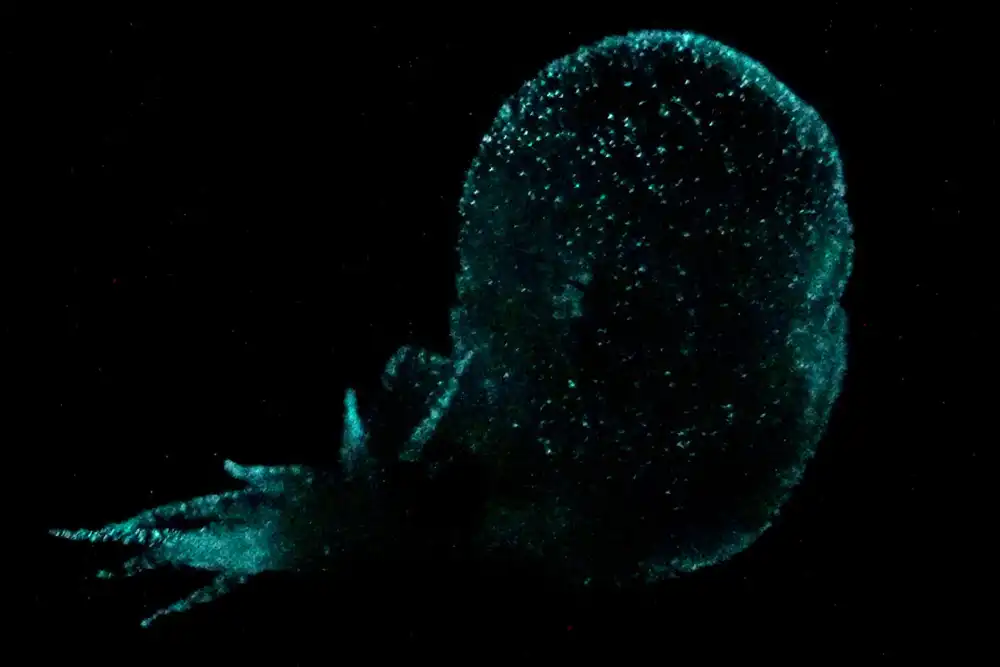Researchers at the Monterey Bay Aquarium Research Institute (MBARI) have discovered a new species of nudibranch – named Bathydevius caudactylus – swimming in the deep waters off the Pacific coast of North America.
Previously nicknamed the ‘mystery mollusc’, the sea slug was first observed in February 2024 during a dive by MBARI’s remotely operated vehicle (ROV) Tiburon at a depth of 2,614m (8,576ft)
Between 2000 and 2021, a total of 157 individuals were sighted, many of them swimming in the water column in open water between depths of 1,000 – 3,300m, a region of the ocean known as the bathypelagic – or midnight – zone.
Other individuals were observed spawning more than 4km below the surface, and the scientists think it may inhabit even deeper waters – a similar-looking creature was spotted by NOAA during a dive in the 11km-deep Marina Trench.
More related science articles
The scientists were able to collect samples of the unknown sea slug during dives by Tiburon and the institute’s second ROV, Doc Ricketts. Eighteen specimens, measuring 56 mm to 145 mm in length, were collected for analysis and DNA sequencing, which showed marked differences to other species of nudibranch.
‘Thanks to MBARI’s advanced underwater technology, we were able to prepare the most comprehensive description of a deep-sea animal ever made,’ said MBARI Senior Scientist and study lead, Bruce Robison.
‘We’ve invested more than 20 years in understanding the natural history of this fascinating species of nudibranch. Our discovery is a new piece of the puzzle that can help better understand the largest habitat on Earth.’
Nudibranchs (the name means ‘naked snails’) will be familiar to most divers and snorkellers, mostly as colourful animals crawling over shallow rocks and coral reefs. They are a type of sea slug, although not all sea slugs are members of the nudibranch family.
Only a small number of nudibranchs are able to swim, such as the famous Spanish dancer (Hexabranchus sanguineus) which is capable of swimming short distances, and the blue angel (also called the blue dragon, Glaucus atlanticus), which spends most of its life swimming near the surface.

Bathydevius caudactylus is the first known species of nudibranch that has been observed swimming in the bathypelagic zone and this ability, a different feeding behaviour and different genetic code mark it out as not just a new species, but a new genus and an entirely new family of nudibranch.
Unlike other nudibranchs, which use a ‘tongue’ to feed on sponges, hydroids and other sessile animals (and each other, in some cases), B. caudactylus has a large hood which it uses to engulf its prey. The hood can also be used to generate a rapid pulse, similar to a jellyfish’s bell, to move the animal out of harm’s way.
The mystery mollusc’s defence mechanism is quite straightforward – apart from the internal organs its body is entirely transparent and remains virtually invisible in the depths.
If it does feel threatened, it is one of only a handful of nudibranch species capable of bioluminescence, which it uses to illuminate one of several ‘finger-like’ appendages protruding from its tail. The glowing finger is then detached, which the scientists believe acts as a decoy enabling the nudibranch to make its quick escape.

The scientific name of the newly described mollusc has been given to reflect these differences – the genus name Bathydevius to describe ‘a deep-living deviation, to reflect its diversion from the evolutionary path of its relatives in appearance, molecular signature, and natural history’; and the species name caudactylus for the finger-like appendages attached to its rear end.
‘What is exciting to me about the mystery mollusc is that it exemplifies how much we are learning as we spend more time in the deep sea, particularly below 2,000 meters,’ said MBARI Senior Scientist Steven Haddock.
‘For there to be a relatively large, unique, and glowing animal that is in a previously unknown family really underscores the importance of using new technology to catalogue this vast environment.
‘The more we learn about deep-sea communities, the better we will be at ocean decision-making and stewardship.’
The complete paper, ‘Discovery and description of a remarkable bathypelagic nudibranch, Bathydevius caudactylus, gen. et sp. nov.’ by Bruce H Robison and Steven HD Haddock is published in Deep Sea Research Part I: Oceanographic Research Papers
This post was originally published on here






